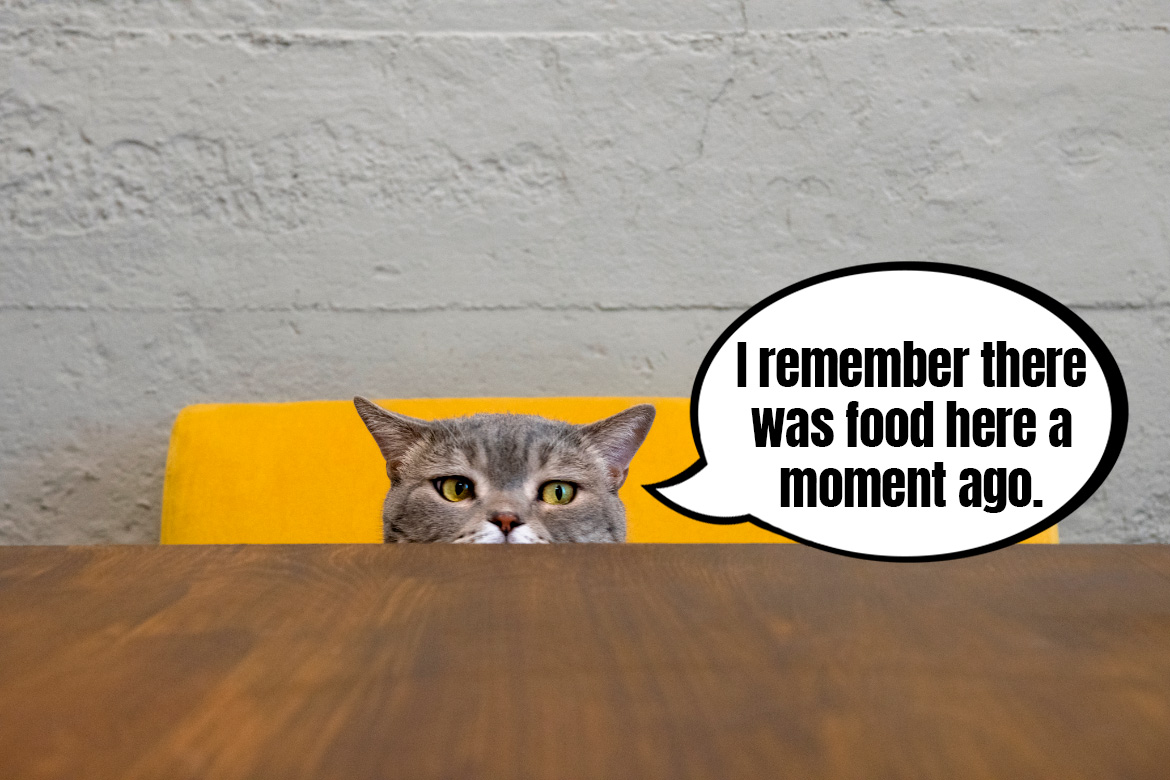Did you ever have a thought: “This cat has such a good memory!”? We definitely did, more than once, especially when our cats started associating particular things we do with them getting a snack reward for it. But it’s not a surprise that our cats’ memory doesn’t work the same as ours does – our furs learn and remember things through actions, experiences, and repetition, forgetting the less important events almost instantly. How does a cat’s memory work in practice and how can we use it to deepen our relationships with our beloved cats? Let’s find out together, fabCats!
How does cats’ memory work?
To start off, let’s talk about memory itself. Cats, similarly to us humans, have both short- and long-term memory. However, for cats, experiences, emotions, and triggers like scents and sounds are the thing that plays a huge role in remembering things (both for short-term memory and lifetime memories). While we can look at a photo and remember things that were happening the day it was taken, our cats will recall certain events based on sounds, smells, or the emotions that they experienced back then – a photo of a toy won’t make them go “oh, it was such a fun toy!”. And, of course, cats do remember and recognize us, their Carers, just by our looks. It’s more important for them, though, to remember our scent and voice. In reality, while our photo might not bring too many emotions up, if we tried to talk to our cat through a phone or in a video call, they will probably go up to the device to check it out 
People can consciously and subconsciously decide which information are important for us to remember long-term. A simple example: someone is giving us their phone number. We remember it for a while until we jot it down on a piece of paper or put it into our phone, but a moment later the numbers are already out of our heads. At the same time, we are able to memorize completely random things – we can forget where we put our house keys, but remember the color of a book cover that someone was reading on the train. Just a little hidden talent of our brains 
Simple needs that give direction to a cat’s life are survival, safety, eating, and hunting and those are the things their memory focuses on the most. In nature, cats will use their short-term memory to hide prey and save it for later. If hunting in a certain spot is successful a few times in a row, information about the place will move to long-term memory to let the cat come back to the spot more often. But will cats remember what the weather was like when they hunted? Or what color were the flowers growing in the grass? Not really, as such information means nothing to them. A domestic cat will also remember where we hid their snacks and even if they eat them all, they’ll definitely be coming back, again and again, to check for more.
Long- and short-term memory in the context of a cat’s life experiences
So what is it with cats and their long-term memory? Can they remember their Carer so well that, even if we were to leave for a few weeks, we’d still be greeted with joy when we get back? And do cats really hold on to traumatic experiences and memories for the rest of their lives? Here, fabCats, we can really envy our feline friends – their long-term memory is really good and it gets better the stronger the emotions associated with a certain event were. Events that affected cats’ safety, well-being, and ability to survive are the most memorable.
Let’s start with the simplest and best motivator of all: food. If we teach our cats that we feed them on the window sill in the kitchen after every playtime, they will quickly remember it’s their designated eating station. Repeating this event daily will reinforce the memory to the point that even if we stopped feeding the cat there, the window sill will be still the spot they check out. Even a few days after we’ve swapped the location of their bowl, the cat can be coming back to the window sill (even after they’ve just eaten) to check if there’s any food left there or, in many cases, check out the window sill first before they go eat in the “new” spot.
And coming back to short-term memory for a little while, there are some fun facts about cats’ ability to remember experiences and live through their experiences. One of them is: cats can’t remember objects that disappear. If we put a toy under a blanket and do nothing with it, even if the cat saw us putting it there, after a moment they’ll probably forget all about it. Why would they need to remember something that doesn’t affect their life and disappeared, ergo, doesn’t exist? However, if we took the toy and started moving it – showing and hiding back again, we are going to wake up the hunting instincts and the cat will happily go for the toy, even if it disappears under the blanket. In fact, they will remember the toy is there and go looking for it, even after we leave it alone.
Let’s remember: repetition, routine and structured schedule are cementing cats’ memories – the more frequently something happens, the more the cat will expect it to happen again! It goes for both good, and bad experiences 
Can we use cats’ memory to work with them?
Of course, we can! Thanks to the fact that cats’ memory works based on their experiences and positive (and negative) reinforcement, basing our work with cats on it is a great way of training. What’s more, many cats love working their brain and reacts amazingly to learning tricks and clicker training. We actually wrote more about clicker training with your cats on our blog recently, so we highly recommend you read more on it here: https://blog.mykotty.pl/2022/09/26/na-czym-polega-trening-z-klikerem/
Cats’ memory is used every day in behavioral work, both when working through trauma and fears and while building up cats’ self-confidence. Cats can have negative connotations with certain people, their tone of voice, different sounds, smells, items, or actions – those negative experiences are stored in the long-term memory, and working through the anxiety requires slow deconstructions of the old memories and substituting them with new, positive ones. Through repetition and structure, we might be able to teach cats that the travel carrier is not the end of the world and nail trimming can get really pleasant 
And how is it for your cats, fabCats? Are they able to remember the tiniest details or are they more of a daydreaming type who, if possible, would probably forget about their own tail? Let us know in the comments and remember to drop us ideas for the next topics you’d like us to cover.




